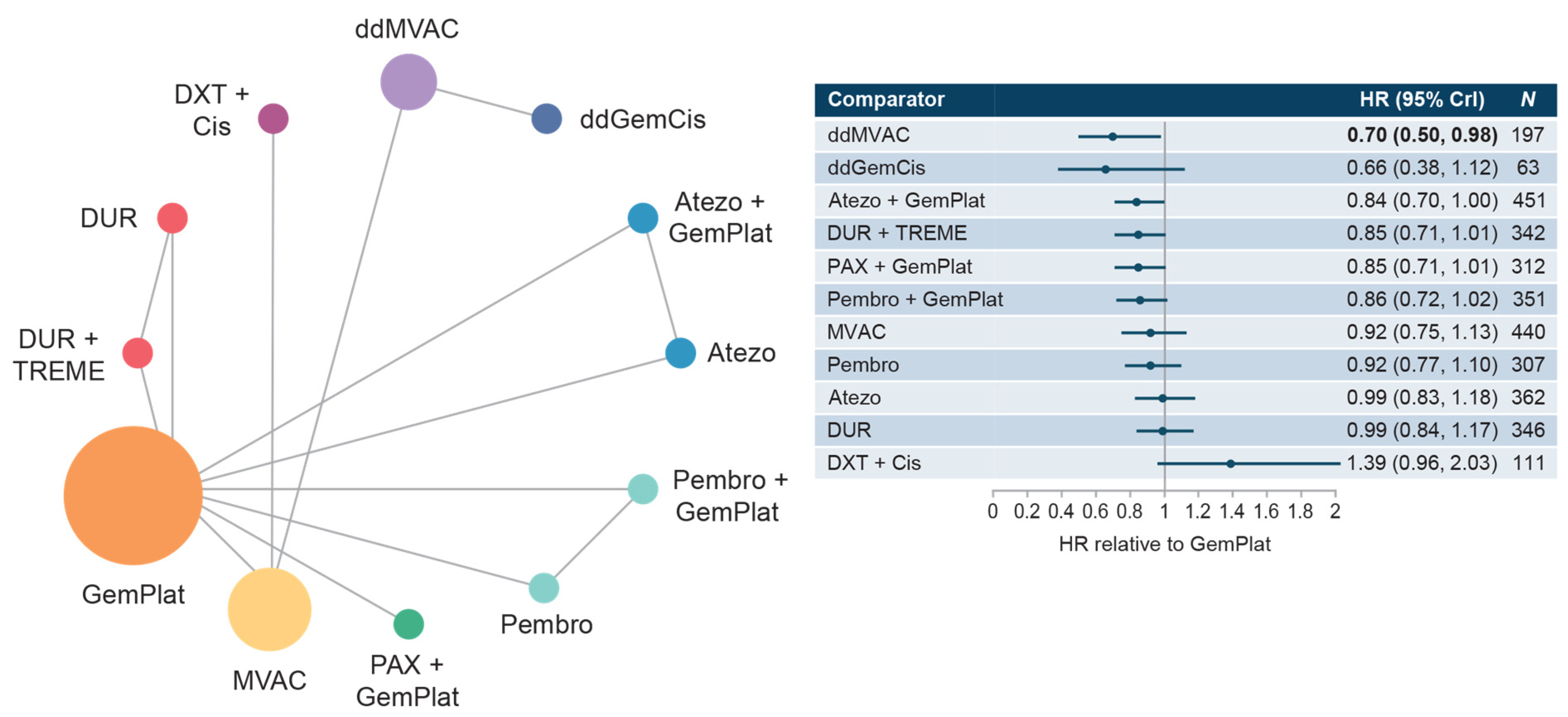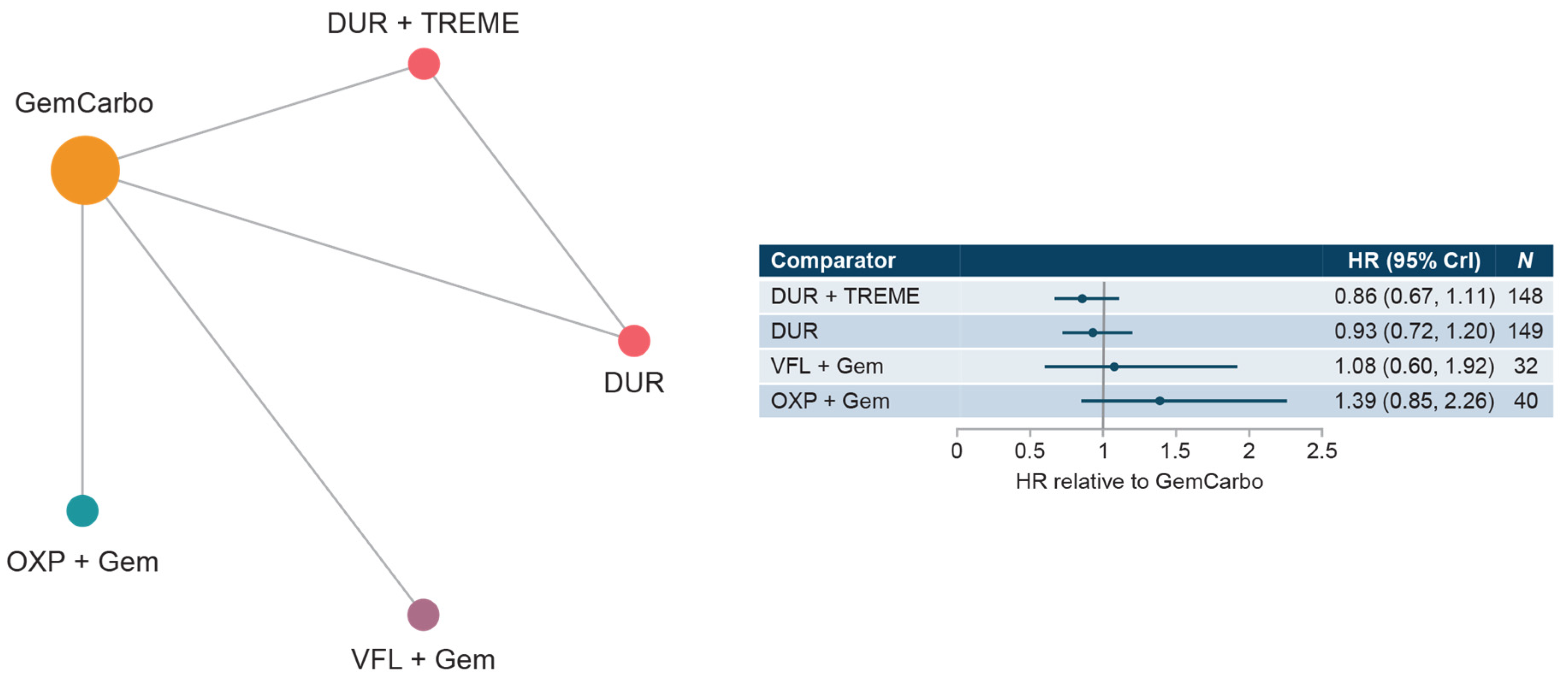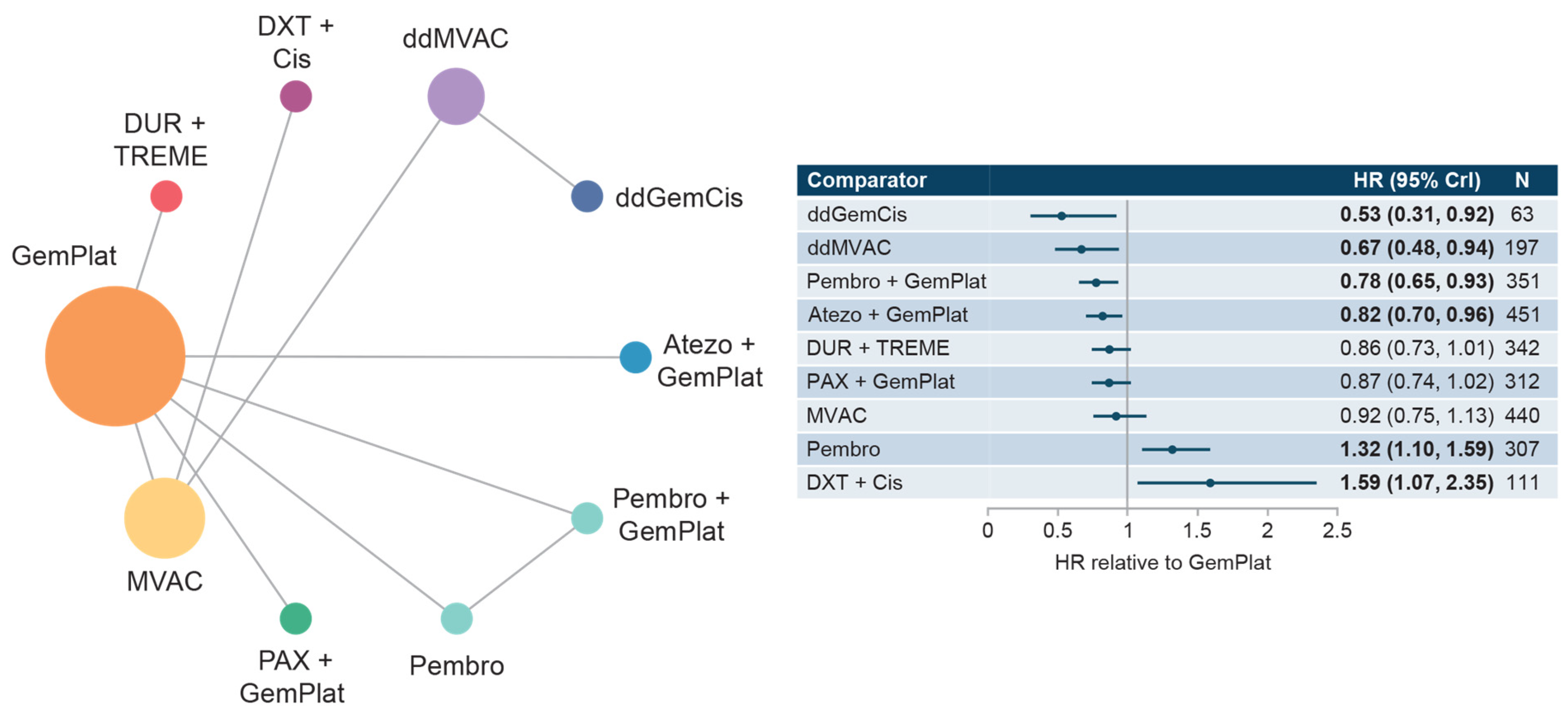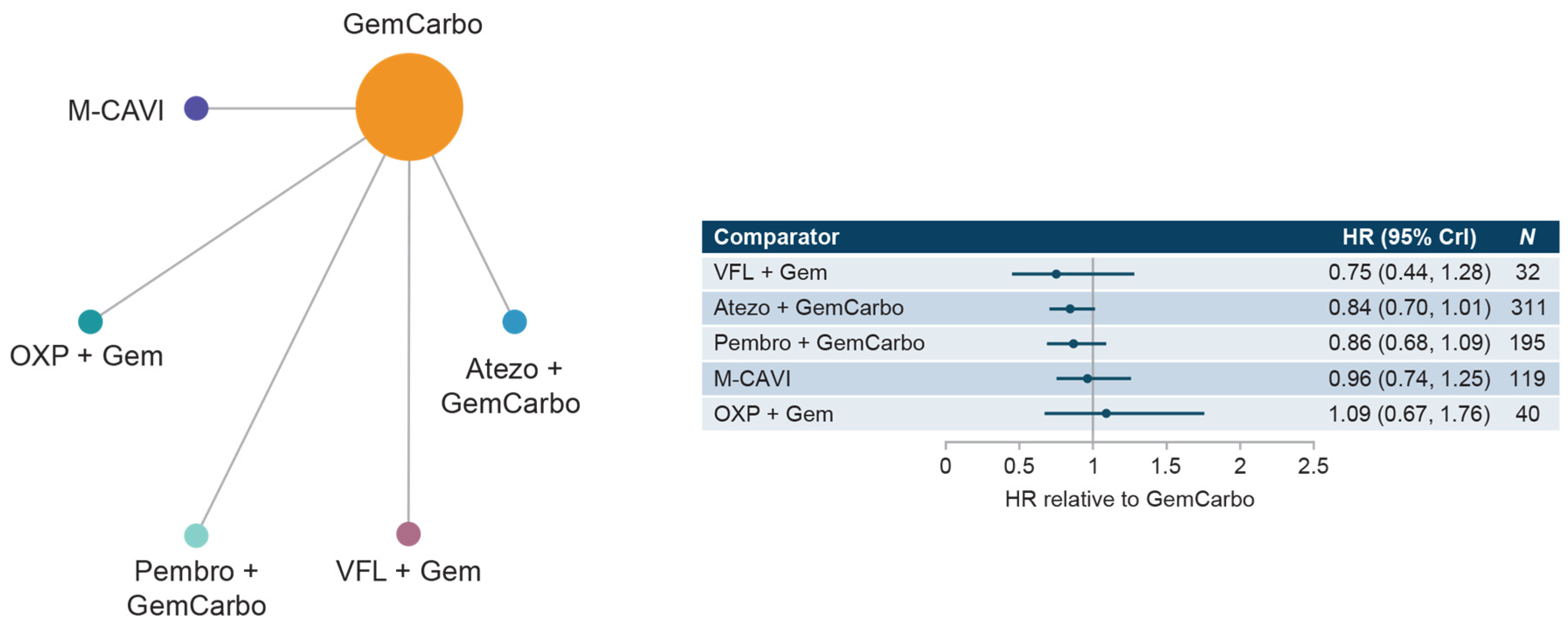Systematic Literature Review (SLR) and Network Meta-Analysis (NMA) of First-Line Therapies (1L) for Locally Advanced/Metastatic Urothelial Carcinoma (la/mUC)
Abstract
1. Introduction
2. Materials and Methods
2.1. Search Strategy
2.2. Inclusion and Exclusion Criteria
2.3. Meta-Analysis Methodology
3. Results
3.1. Study Selection and Characteristics
3.2. Network Meta-Analysis
3.3. Overall Survival by Treatment Network
3.3.1. Cis-Eligible/Mixed Network
3.3.2. Cis-Ineligible (Wide) Network
3.3.3. Cis-Ineligible (Strict) Network
3.4. Progression-Free Survival by Treatment Network
3.4.1. Cis-Eligible/Mixed Network
3.4.2. Cis-Ineligible (Wide) + Cis-Ineligible (Strict) Networks
3.5. Overall Response Rate by Treatment Network
4. Discussion
Limitations
5. Conclusions
Supplementary Materials
Author Contributions
Funding
Data Availability Statement
Acknowledgments
Conflicts of Interest
References
- National Institutes of Health; National Cancer Institute; Surveillance Epidemiology and End Results Program. Cancer Stat Facts: Bladder Cancer. Available online: https://seer.cancer.gov/statfacts/html/urinb.html (accessed on 22 July 2022).
- Ripoll, J.; Ramos, M.; Montaño, J.; Pons, J.; Ameijide, A.; Franch, P. Cancer-specific survival by stage of bladder cancer and factors collected by Mallorca Cancer Registry associated to survival. BMC Cancer 2021, 21, 676. [Google Scholar] [CrossRef]
- National Comprehensive Cancer Network NCCN. NCCN Clinical Practice Guidelines in Oncology (NCCN Guidelines). Bladder Cancer. 2022. Available online: nccn.org (accessed on 9 August 2022).
- Powles, T.; Bellmunt, J.; Comperat, E.; De Santis, M.; Huddart, R.; Loriot, Y.; Necchi, A.; Valderrama, B.P.; Ravaud, A.; Shariat, S.F.; et al. Bladder cancer: ESMO Clinical Practice Guideline for diagnosis, treatment and follow-up. Ann. Oncol. 2021, 33, 244–258. [Google Scholar] [CrossRef] [PubMed]
- Galsky, M.D.; Hahn, N.M.; Rosenberg, J.; Sonpavde, G.; Hutson, T.; Oh, W.K.; Dreicer, R.; Vogelzang, N.; Sternberg, C.N.; Bajorin, D.F.; et al. Treatment of Patients with Metastatic Urothelial Cancer “Unfit” for Cisplatin-Based Chemotherapy. J. Clin. Oncol. 2011, 29, 2432–2438. [Google Scholar] [CrossRef] [PubMed]
- Hoaglin, D.C.; Hawkins, N.; Jansen, J.P.; Scott, D.A.; Itzler, R.; Cappelleri, J.C.; Boersma, C.; Thompson, D.; Larholt, K.M.; Diaz, M.; et al. Conducting Indirect-Treatment-Comparison and Network-Meta-Analysis Studies: Report of the ISPOR Task Force on Indirect Treatment Comparisons Good Research Practices: Part 2. Value Health 2011, 14, 429–437. [Google Scholar] [CrossRef] [PubMed]
- Dias, S.; Welton, N.J.; Sutton, A.J.; Ades, A.E. NICE Decision Support Unit Technical Support Documents. In NICE DSU Technical Support Document 2: A Generalised Linear Modelling Framework for Pairwise and Network Meta-Analysis of Randomised Controlled Trials; National Institute for Health and Care Excellence (NICE): London, UK, 2014. [Google Scholar]
- Alva, A.; Csőszi, T.; Ozguroglu, M.; Matsubara, N.; Geczi, L.; Cheng, S.Y.-S.; Fradet, Y.; Oudard, S.; Vulsteke, C.; Barrera, R.M.; et al. LBA23 Pembrolizumab (P) combined with chemotherapy (C) vs C alone as first-line (1L) therapy for advanced urothelial carcinoma (UC): KEYNOTE-361. Ann. Oncol. 2020, 31 (Suppl. 4), S1155. [Google Scholar] [CrossRef]
- Galsky, M.D.; Arija, J.Á.A.; Bamias, A.; Davis, I.D.; De Santis, M.; Kikuchi, E.; Garcia-Del-Muro, X.; De Giorgi, U.; Mencinger, M.; Izumi, K.; et al. Atezolizumab with or without chemotherapy in metastatic urothelial cancer (IMvigor130): A multicentre, randomised, placebo-controlled phase 3 trial. Lancet 2020, 395, 1547–1557. [Google Scholar] [CrossRef]
- Powles, T.; van der Heijden, M.S.; Castellano, D.; Galsky, M.D.; Loriot, Y.; Petrylak, D.P.; Ogawa, O.; Park, S.H.; Lee, J.-L.; De Giorgi, U.; et al. Durvalumab alone and durvalumab plus tremelimumab versus chemotherapy in previously untreated patients with unresectable, locally advanced or metastatic urothelial carcinoma (DANUBE): A randomised, open-label, multicentre, phase 3 trial. Lancet Oncol. 2020, 21, 1574–1588. [Google Scholar] [CrossRef]
- Higgins, J.; Li, T.; Deeks, J. Cochrane Handbook for Systematic Reviews of Interventions; Version 6.0 (Updated July 2019); John Wiley & Sons: Hoboken, NJ, USA, 2019; pp. 143–176. [Google Scholar] [CrossRef]
- Powles, T.; Csőszi, T.; Özgüroğlu, M.; Matsubara, N.; Géczi, L.; Cheng, S.Y.; Fradet, Y.; Oudard, S.; Vulsteke, C.; Barrera, R.M.; et al. Pembrolizumab alone or combined with chemotherapy versus chemotherapy as first-line therapy for advanced urothelial carcinoma (KEYNOTE-361): A randomised, open-label, phase 3 trial. Lancet Oncol. 2021, 22, 931–945. [Google Scholar] [CrossRef]
- Davis, I.D.; Galsky, M.D.; del Muro, X.G.; Park, S.H.; De Giorgi, U.; Alekseev, B.; Mencinger, M.; Izumi, K.; Puente, J.; Li, J.-R.; et al. Abstract CT040: Updated overall survival (OS) analysis of atezolizumab (atezo) monotherapy vs chemotherapy in untreated locally advanced or metastatic urothelial carcinoma (mUC) in IMvigor130. Cancer Res. 2021, 81 (Suppl. 13), CT040. [Google Scholar] [CrossRef]
- Dash, A.; Galsky, M.D.; Vickers, A.J.; Serio, A.M.; Koppie, T.M.; Dalbagni, G.; Bochner, B.H. Impact of renal impairment on eligibility for adjuvant cisplatin-based chemotherapy in patients with urothelial carcinoma of the bladder. Cancer 2006, 107, 506–513. [Google Scholar] [CrossRef]
- Powles, T.; Park, S.H.; Voog, E.; Caserta, C.; Valderrama, B.P.; Gurney, H.; Kalofonos, H.; Radulović, S.; Demey, W.; Ullén, A.; et al. Avelumab Maintenance Therapy for Advanced or Metastatic Urothelial Carcinoma. N. Engl. J. Med. 2020, 383, 1218–1230. [Google Scholar] [CrossRef]
- von der Maase, H.; Sengelov, L.; Roberts, J.T.; Ricci, S.; Dogliotti, L.; Oliver, T.; Moore, M.J.; Zimmermann, A.; Arning, M. Long-Term Survival Results of a Randomized Trial Comparing Gemcitabine Plus Cisplatin, With Methotrexate, Vinblastine, Doxorubicin, Plus Cisplatin in Patients with Bladder Cancer. J. Clin. Oncol. 2005, 23, 4602–4608. [Google Scholar] [CrossRef]
- Freshwater, T.; Li, H.; Valiathan, C.; Li, M.; Perini, R.; Bracco, O.L.; Frenkl, T.; Keefe, S. Systematic Literature Review and Meta-Analysis of Response to First-Line Therapies for Advanced/Metastatic Urothelial Cancer Patients Who Are Cisplatin Ineligible. Am. J. Clin. Oncol. 2019, 42, 802–809. [Google Scholar] [CrossRef] [PubMed]
- Holmsten, K.; Jensen, N.V.; Mouritsen, L.S.; Jonsson, E.; Mellnert, C.; Agerbaek, M.; Nilsson, C.; Moe, M.; Carus, A.; Öfverholm, E.; et al. Vinflunine/gemcitabine versus carboplatin/gemcitabine as first-line treatment in cisplatin-ineligible patients with advanced urothelial carcinoma: A randomised phase II trial (VINGEM). Eur. J. Cancer 2020, 127, 173–182. [Google Scholar] [CrossRef] [PubMed]
- Chen, H.-L.; Chan, V.W.; Tu, Y.-K.; Chan, E.O.; Chang, H.-M.; Juan, Y.-S.; Teoh, J.Y.; Lee, H.Y. Immune Checkpoints Inhibitors and Chemotherapy as First-Line Treatment for Metastatic Urothelial Carcinoma: A Network Meta-Analysis of Randomized Phase III Clinical Trials. Cancers 2021, 13, 1484. [Google Scholar] [CrossRef]
- Mori, K.; Pradere, B.; Moschini, M.; Mostafaei, H.; Laukhtina, E.; Schuettfort, V.M.; Motlagh, R.S.; Soria, F.; Teoh, J.Y.C.; Egawa, S.; et al. First-line immune-checkpoint inhibitor combination therapy for chemotherapy-eligible patients with metastatic urothelial carcinoma: A systematic review and meta-analysis. Eur. J. Cancer 2021, 151, 35–48. [Google Scholar] [CrossRef]
- Galksy, M.D.; Arija, J.A.A.; De Santis, M.; Davis, I.D.; Bamias, A.; Kikuchi, E.; del Muro, X.G.; Park, S.E.; De Giorgi, U.; Alekseev, B.; et al. Atezolizumab (atezo) + platinum/gemcitabine (plt/gem) vs placebo + plt/gem for first-line (1L) treatment (tx) of locally advanced or metastatic urothelial carcinoma (mUC): Final OS from the randomized Phase 3 IMvigor130 study. J. Clin. Oncol. 2023, 41, LBA440. [Google Scholar]
- Tap, W.D.; Jones, R.L.; A Van Tine, B.; Chmielowski, B.; Elias, A.D.; Adkins, D.; Agulnik, M.; Cooney, M.M.; Livingston, M.B.; Pennock, G.; et al. Olaratumab and doxorubicin versus doxorubicin alone for treatment of soft-tissue sarcoma: An open-label phase 1b and randomised phase 2 trial. Lancet 2016, 388, 488–497. [Google Scholar] [CrossRef]
- Delgado, A.; Guddati, A.K. Clinical endpoints in oncology—A primer. Am. J. Cancer Res. 2021, 11, 1121–1131. [Google Scholar]
- Park, I.; Kim, B.-S.; Lim, H.Y.; Kim, H.-J.; Lee, H.J.; Choi, Y.J.; Park, K.H.; Lee, K.H.; Yoon, S.; Hong, B.; et al. Gemcitabine plus carboplatin versus gemcitabine plus oxaliplatin in cisplatin-unfit patients with advanced urothelial carcinoma: A randomised phase II study (COACH, KCSG GU10-16). Eur. J. Cancer 2020, 127, 183–190. [Google Scholar] [CrossRef]
- Bamias, A.; Dafni, U.; Karadimou, A.; Timotheadou, E.; Aravantinos, G.; Psyrri, A.; Xanthakis, I.; Tsiatas, M.; Koutoulidis, V.; Constantinidis, C.; et al. Prospective, open-label, randomized, phase III study of two dose-dense regimens MVAC versus gemcitabine/cisplatin in patients with inoperable, metastatic or relapsed urothelial cancer: A Hellenic Cooperative Oncology Group study (HE 16/03). Ann. Oncol. 2013, 24, 1011–1017. [Google Scholar] [CrossRef] [PubMed]
- Wang, Y.; Xu, L.; Meng, X.; Qin, Z.; Wang, Y.; Chen, C.; Wang, Y.; Zhou, X.; Zhang, Q.; Xia, J.; et al. Different Chemotherapy Regimens in the Management of Advanced or Metastatic Urothelial Cancer: A Bayesian Network Meta-Analysis of Randomized Controlled Trials. Cell. Physiol. Biochem. 2018, 50, 1–14. [Google Scholar] [CrossRef] [PubMed]
- Rosenberg, J.E.; Milowsky, M.; Ramamurthy, C.; Mar, N.; McKay, R.R.; Friedlander, T.; Ferrario, C.; Bracarda, S.; George, S.; Moon, H.; et al. LBA73 Study EV-103 Cohort K: Antitumor activity of enfortumab vedotin (EV) monotherapy or in combination with pembrolizumab (P) in previously untreated cisplatin-ineligible patients (pts) with locally advanced or metastatic urothelial cancer (la/mUC). Ann. Oncol. 2022, 33, S1441. [Google Scholar] [CrossRef]
- Sternberg, C.N.; de Mulder, P.; Schornagel, J.H.; Theodore, C.; Fossa, S.D.; van Oosterom, A.T.; Witjes, J.A.; Spina, M.; van Groeningen, C.J.; Duclos, B.; et al. Seven year update of an EORTC phase III trial of high-dose intensity M-VAC chemotherapy and G-CSF versus classic M-VAC in advanced urothelial tract tumours. Eur. J. Cancer 2006, 42, 50–54. [Google Scholar] [CrossRef]
- De Santis, M.; Bellmunt, J.; Mead, G.; Kerst, J.M.; Leahy, M.; Maroto, P.; Gil, T.; Marreaud, S.; Daugaard, G.; Skoneczna, I.; et al. Randomized Phase II/III Trial Assessing Gemcitabine/Carboplatin and Methotrexate/Carboplatin/Vinblastine in Patients with Advanced Urothelial Cancer Who Are Unfit for Cisplatin-Based Chemotherapy: EORTC Study 30986. J. Clin. Oncol. 2012, 30, 191–199. [Google Scholar] [CrossRef] [PubMed]
- Culine, S.; Fléchon, A.; Guillot, A.; Le Moulec, S.; Pouessel, D.; Rolland, F.; Ravaud, A.; Houédé, N.; Mignot, L.; Joly, F.; et al. Gemcitabine or Gemcitabine Plus Oxaliplatin in the First-Line Treatment of Patients with Advanced Transitional Cell Carcinoma of the Urothelium Unfit for Cisplatin-Based Chemotherapy: A Randomized Phase 2 Study of the French Genitourinary Tumor Group (GETUG V01). Eur. Urol. 2011, 60, 1251–1257. [Google Scholar] [CrossRef] [PubMed]
- De Santis, M.; Wiechno, P.J.; Bellmunt, J.; Lucas, C.; Su, W.-C.; Albiges, L.; Lin, C.-C.; Senkus-Konefka, E.; Flechon, A.; Mourey, L.; et al. Vinflunine–gemcitabine versus vinflunine–carboplatin as first-line chemotherapy in cisplatin-unfit patients with advanced urothelial carcinoma: Results of an international randomized phase II trial (JASINT1). Ann. Oncol. 2016, 27, 449–454. [Google Scholar] [CrossRef] [PubMed]
- Bamias, A.; Aravantinos, G.; Deliveliotis, C.; Bafaloukos, D.; Kalofonos, C.; Xiros, N.; Zervas, A.; Mitropoulos, D.; Samantas, E.; Pectasides, D.; et al. Docetaxel and Cisplatin with Granulocyte Colony-Stimulating Factor (G-CSF) Versus MVAC With G-CSF in Advanced Urothelial Carcinoma: A Multicenter, Randomized, Phase III Study From the Hellenic Cooperative Oncology Group. J. Clin. Oncol. 2004, 22, 220–228. [Google Scholar] [CrossRef]
- Dogliotti, L.; Cartenì, G.; Siena, S.; Bertetto, O.; Martoni, A.; Bono, A.; Amadori, D.; Onat, H.; Marini, L. Gemcitabine plus Cisplatin versus Gemcitabine plus Carboplatin as First-Line Chemotherapy in Advanced Transitional Cell Carcinoma of the Urothelium: Results of a Randomized Phase 2 Trial. Eur. Urol. 2007, 52, 134–141. [Google Scholar] [CrossRef]
- Dreicer, R.; Manola, J.; Roth, B.J.; See, W.A.; Kuross, S.; Edelman, M.J.; Hudes, G.R.; Wilding, G. Phase III trial of methotrexate, vinblastine, doxorubicin, and cisplatin versus carboplatin and paclitaxel in patients with advanced carcinoma of the urothelium. Cancer 2004, 100, 1639–1645. [Google Scholar] [CrossRef]
- Lorusso, V.; Crucitta, E.; Silvestris, N.; Rosati, G.; Manzione, L.; De Lena, M.; Palmeri, S.; Gebbia, V.; Mancarella, S.; Sobrero, A.; et al. Randomised, open-label, phase II trial of paclitaxel, gemcitabine and cisplatin versus gemcitabine and cisplatin as first-line chemotherapy in advanced transitional cell carcinoma of the urothelium. Oncol. Rep. 2005, 13, 283–287. [Google Scholar]
- Siefker-Radtke, A.O.; Millikan, R.E.; Tu, S.-M.; Moore, D.F., Jr.; Smith, T.L.; Williams, D.; Logothetis, C.J. Phase III Trial of Fluorouracil, Interferon Alfa-2b, and Cisplatin Versus Methotrexate, Vinblastine, Doxorubicin, and Cisplatin in Metastatic or Unresectable Urothelial Cancer. J. Clin. Oncol. 2002, 20, 1361–1367. [Google Scholar] [CrossRef]
- Bellmunt, J.; von der Maase, H.; Mead, G.M.; Skoneczna, I.; De Santis, M.; Daugaard, G.; Boehle, A.; Chevreau, C.; Paz-Ares, L.; Laufman, L.R.; et al. Randomized phase III study comparing paclitaxel/cisplatin/gemcitabine and gemcitabine/cisplatin in patients with locally advanced or metastatic urothelial cancer without prior systemic therapy: EORTC Intergroup Study 30987. J. Clin. Oncol. 2012, 30, 1107–1113. [Google Scholar] [CrossRef] [PubMed]
- Powles, T.; van der Heijden, M.S.; Gauna, D.C.; Loriot, Y.; Galsky, M.D.; Petrylak, D.P.; Ogawa, O.; Park, S.-H.; Necchi, A.; Lee, J.-L.; et al. 697O A phase III, randomized, open-label study of first-line durvalumab (D) with or without tremelimumab (T) vs. standard of care chemotherapy in patients with unresectable, locally advanced or metastatic urothelial carcinoma (DANUBE). Ann. Oncol. 2020, 31, S550–S551. [Google Scholar] [CrossRef]
- Powles, T.; Csőszi, T.; Ozguroglu, M.; Matsubara, N.; Geczi, L.; Cheng, S.Y.; Fradet, Y.; Oudard, S.; Vulsteke, C.; Morales-Barrera, R.; et al. 1L pembrolizumab (pembro) versus chemotherapy (chemo) for choice-of-carboplatin patients with advanced urothelial carcinoma (UC) in KEYNOTE-361. J. Clin. Oncol. 2021, 39, 450. [Google Scholar]






Disclaimer/Publisher’s Note: The statements, opinions and data contained in all publications are solely those of the individual author(s) and contributor(s) and not of MDPI and/or the editor(s). MDPI and/or the editor(s) disclaim responsibility for any injury to people or property resulting from any ideas, methods, instructions or products referred to in the content. |
© 2023 by the authors. Licensee MDPI, Basel, Switzerland. This article is an open access article distributed under the terms and conditions of the Creative Commons Attribution (CC BY) license (https://creativecommons.org/licenses/by/4.0/).
Share and Cite
Bloudek, L.; Wright, P.; McKay, C.; Derleth, C.L.; Lill, J.S.; Lenero, E.; Hepp, Z.; Ramsey, S.D.; Sullivan, S.D.; Devine, B. Systematic Literature Review (SLR) and Network Meta-Analysis (NMA) of First-Line Therapies (1L) for Locally Advanced/Metastatic Urothelial Carcinoma (la/mUC). Curr. Oncol. 2023, 30, 3637-3647. https://doi.org/10.3390/curroncol30040277
Bloudek L, Wright P, McKay C, Derleth CL, Lill JS, Lenero E, Hepp Z, Ramsey SD, Sullivan SD, Devine B. Systematic Literature Review (SLR) and Network Meta-Analysis (NMA) of First-Line Therapies (1L) for Locally Advanced/Metastatic Urothelial Carcinoma (la/mUC). Current Oncology. 2023; 30(4):3637-3647. https://doi.org/10.3390/curroncol30040277
Chicago/Turabian StyleBloudek, Lisa, Phoebe Wright, Caroline McKay, Christina Louise Derleth, Jennifer Susan Lill, Enrique Lenero, Zsolt Hepp, Scott David Ramsey, Sean D. Sullivan, and Beth Devine. 2023. "Systematic Literature Review (SLR) and Network Meta-Analysis (NMA) of First-Line Therapies (1L) for Locally Advanced/Metastatic Urothelial Carcinoma (la/mUC)" Current Oncology 30, no. 4: 3637-3647. https://doi.org/10.3390/curroncol30040277
APA StyleBloudek, L., Wright, P., McKay, C., Derleth, C. L., Lill, J. S., Lenero, E., Hepp, Z., Ramsey, S. D., Sullivan, S. D., & Devine, B. (2023). Systematic Literature Review (SLR) and Network Meta-Analysis (NMA) of First-Line Therapies (1L) for Locally Advanced/Metastatic Urothelial Carcinoma (la/mUC). Current Oncology, 30(4), 3637-3647. https://doi.org/10.3390/curroncol30040277




